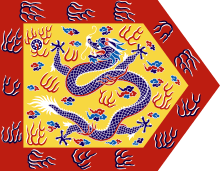Bordered Yellow Banner
The Bordered Yellow Banner (simplified Chinese: 镶黄旗; traditional Chinese: 鑲黃旗; pinyin: Xiāng Huáng Qí) was one of the Eight Banners of Manchu military and society during the Later Jin and Qing dynasty of China. The Bordered Yellow Banner was one of three "upper" banner armies under the direct command of the emperor himself, and one of the four "left wing" banners.[1] The Plain Yellow Banner and the Bordered Yellow Banner were split from each other in 1615, when the troops of the original four banner armies (Yellow, Blue, Red, and White) were divided into eight by adding a bordered variant to each banner's design.[2] The yellow banners were originally commanded personally by Nurhaci. After Nurhaci's death, his son Hong Taiji became khan, and took control of both yellow banners. Later, the Shunzhi Emperor took over the Plain White Banner after the death of his regent, Dorgon, to whom it previously belonged. From that point forward, the emperor directly controlled three "upper" banners (Plain Yellow, Bordered Yellow, and Plain White), as opposed to the other five "lower" banners.[3][4] Because of the direct control of the three upper banners, there was no appointed banner commanders as opposed to the other five. The emperor's personal guards and guards of Forbidden City were also only selected from the upper three banners.[5]
| Bordered Yellow Banner | |
|---|---|
 Flag of the Bordered Yellow Banner | |
| Active | 1615 – 1911 |
| Country | Later Jin |
| Type | cavalry, musketeers |
| Part of | Eight Banners |
| Commander | the Emperor |
| Bordered Yellow Banner | |||||||
|---|---|---|---|---|---|---|---|
| Chinese name | |||||||
| Chinese | 鑲黃旗 | ||||||
| |||||||
| Mongolian name | |||||||
| Mongolian Cyrillic | Хөвөөт Шар Хошуу | ||||||
| Manchu name | |||||||
| Manchu script | ᡴᡠᠪᡠᡥᡝ ᠰᡠᠸᠠᠶᠠᠨ ᡤᡡᠰᠠ | ||||||
| Romanization | kubuhe suwayan gūsa | ||||||
Notable people
Notable clans
- Fuca clan
- Niohuru
- Tunggiya
- Sakda
- Nian
- Gao
- Erdet
- Gūwalgiya
- Zhangjia
- Duola'er
- Zhalali
- Fan
- Wei
- Ma
- Zhao
- Shi
References
- Elliott 2001, p. 79.
- Elliott 2001, p. 59.
- Wakeman 1985, p. 158.
- Elliott 2001, pp. 404-405.
- 清史稿
Bibliography
- Elliott, Mark C. (2001), The Manchu Way: The Eight Banners and Ethnic Identity in Late Imperial China, Stanford University Press, ISBN 9780804746847
- Wakeman Jr., Frederic (1985), The Great Enterprise: The Manchu Reconstruction of Imperial Order in Seventeenth-century China, Berkeley: University of California Press, ISBN 0520048040
Further reading
- Dennerline, Jerry (2002), "The Shun-Chih Reign", in Peterson, Willard J.; Twitchett, Denis Crispin; Fairbank, John King (eds.), The Cambridge History of China: Volume 9, Part 1, The Ch'ing Empire to 1800, The Cambridge History of China, 9, Cambridge University Press, ISBN 9780521243346
- Rawski, Evelyn S. (1998), The Last Emperors: A Social History of Qing Imperial Institutions, University of California Press, ISBN 9780520926790